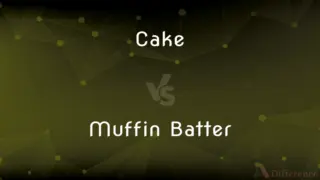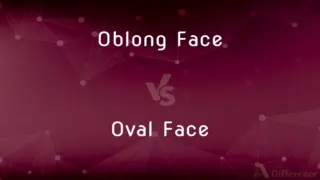Chain Growth Polymerization vs. Step Growth Polymerization — What's the Difference?
By Tayyaba Rehman — Published on December 13, 2023
Chain Growth Polymerization involves monomers adding sequentially to a growing chain. Step Growth Polymerization has monomers bond in a step-by-step manner without a free-radical chain.

Difference Between Chain Growth Polymerization and Step Growth Polymerization
Table of Contents
ADVERTISEMENT
Key Differences
Chain Growth Polymerization and Step Growth Polymerization are both vital mechanisms in polymer science, responsible for the formation of large molecules from smaller units. Chain Growth Polymerization is a process wherein monomers, with unsaturated bonds, react sequentially, usually initiated by a radical, ion, or coordination complex, adding to a growing polymer chain one monomer at a time.
On the flip side, Step Growth Polymerization doesn’t rely on the sequential addition of monomers to a single growing chain. Instead, it involves reactions between functional groups of monomers, causing a step-by-step growth where small molecules can react with larger ones. In Step Growth Polymerization, there isn't a distinction between initiator and monomer as in Chain Growth Polymerization.
When one examines Chain Growth Polymerization, it's noted that it often requires an initiator, a compound that starts the polymerization process. The active center of the growing chain, like a free radical, is typically maintained throughout the process. This method ensures rapid chain elongation.
In contrast, Step Growth Polymerization often involves bifunctional or multifunctional monomers. This means that the monomers contain two or more reactive groups. As they react, small molecules may form first, followed by larger chains, eventually leading to high molecular weight polymers. Unlike Chain Growth Polymerization, the molecular weight increases gradually.
Comparison Chart
Mechanism Type
Radical, ionic, or coordination complex driven
Functional group reactions between monomers
ADVERTISEMENT
Growth Pattern
Sequential addition to growing chain
Step-by-step growth
Initiator Requirement
Often requires an initiator
Doesn't distinctively need an initiator
Monomer Type
Usually unsaturated
Bifunctional or multifunctional
Molecular Weight Development
Rapid increase in the beginning
Gradually increases throughout
Compare with Definitions
Chain Growth Polymerization
Polymer growth relying on active centers like radicals.
Chain Growth Polymerization maintains the active center throughout the polymerization process.
Step Growth Polymerization
Polymerization involving step-by-step growth of molecules.
In Step Growth Polymerization, monomers with multiple functional groups react progressively.
Chain Growth Polymerization
A process where unsaturated monomers add to a polymer chain one at a time.
Chain Growth Polymerization is distinct due to its sequential monomer addition mechanism.
Step Growth Polymerization
Reaction between monomers' functional groups leading to polymers.
Bifunctional monomers are key to Step Growth Polymerization, enabling continuous growth.
Chain Growth Polymerization
A polymerization method where monomers add sequentially to a growing chain.
The radical initiation in Chain Growth Polymerization ensures the sequential addition of monomers.
Step Growth Polymerization
Polymer growth without maintaining a consistent active center.
Unlike its counterpart, Step Growth Polymerization doesn't rely on a free radical chain throughout.
Chain Growth Polymerization
A rapid chain elongation polymer formation mechanism.
Chain Growth Polymerization leads to quick molecular weight jumps early in the process.
Step Growth Polymerization
Polymer formation where small molecules can react with larger ones.
Step Growth Polymerization allows for a varied chain length during the process.
Chain Growth Polymerization
Initiated by a compound, leading to sequential monomer addition.
In Chain Growth Polymerization, the initiator plays a crucial role in starting the polymer chain.
Step Growth Polymerization
A mechanism with gradual molecular weight increase.
The molecular weight in Step Growth Polymerization doesn't spike immediately but increases over time.
Common Curiosities
Can both methods be used for the same monomers?
Not always, as they require different functional groups or unsaturation levels.
Do both polymerization methods lead to high molecular weight polymers?
Yes, but Chain Growth Polymerization often achieves this faster than Step Growth Polymerization.
Can both polymerization methods be used in industrial applications?
Yes, both are utilized, but the choice depends on the desired polymer properties.
Is an initiator always needed for Chain Growth Polymerization?
Typically, yes, an initiator starts Chain Growth Polymerization.
Why are bifunctional monomers significant for Step Growth Polymerization?
They contain multiple reactive groups, allowing continuous chain growth.
Can Step Growth Polymerization create copolymers?
Yes, by using different types of bifunctional monomers.
Which method leads to a more controlled polymer structure?
It varies, but Chain Growth Polymerization often provides more control due to its sequential nature.
Is the end product always a high molecular weight polymer?
Generally, yes, but the time and steps to reach it vary between Chain Growth and Step Growth Polymerization.
Is Chain Growth Polymerization faster than Step Growth Polymerization?
The chain elongation in Chain Growth Polymerization is usually more rapid.
Are there environmental concerns with either method?
Both methods can have environmental impacts, depending on the monomers and conditions used.
How does the molecular weight distribution compare between the two?
Chain Growth Polymerization typically has a narrower distribution, while Step Growth Polymerization can be broader.
Is Chain Growth Polymerization more predictable than Step Growth Polymerization?
It often is, due to its sequential and controlled nature.
Can external factors, like catalysts, be used in both methods?
Yes, catalysts and other factors can be utilized to control and expedite the polymerization processes.
How important is the choice of initiator in Chain Growth Polymerization?
Very, as it influences the polymer's properties and molecular weight.
How does temperature affect both polymerization methods?
Temperature can influence reaction rates, molecular weight, and polymer structure in both methods.
Share Your Discovery

Previous Comparison
Cake vs. Muffin Batter
Next Comparison
Oblong Face vs. Oval FaceAuthor Spotlight
Written by
Tayyaba RehmanTayyaba Rehman is a distinguished writer, currently serving as a primary contributor to askdifference.com. As a researcher in semantics and etymology, Tayyaba's passion for the complexity of languages and their distinctions has found a perfect home on the platform. Tayyaba delves into the intricacies of language, distinguishing between commonly confused words and phrases, thereby providing clarity for readers worldwide.












































